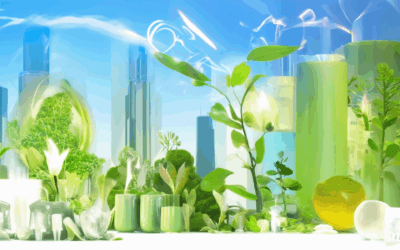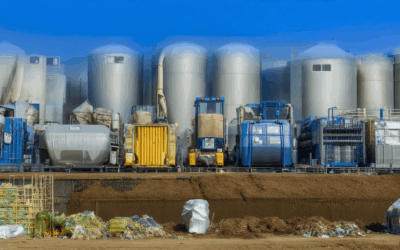Eco-friendly carbon sequestration has emerged as a critical strategy in the global effort to combat climate change. By capturing and storing carbon from the atmosphere, these methods not only reduce greenhouse gas emissions but also contribute to the restoration of ecosystems. In this comprehensive guide, we explore the most effective ways to implement eco-friendly carbon sequestration, focusing on natural methods, plants, and sustainable practices that can make a meaningful impact. From understanding the best natural carbon sequestration techniques to evaluating the role of grass as a carbon sink, this article delves into the science and practicality of harnessing nature to mitigate climate change. Whether you’re looking to adopt eco-friendly practices in your own environment or seeking scalable solutions for broader applications, this guide provides valuable insights and actionable strategies to get started.

Best Natural Carbon Sequestration Methods
Carbon sequestration refers to the process of capturing and storing carbon dioxide (CO2) from the atmosphere, thereby reducing greenhouse gas emissions and mitigating climate change. Here are some of the most effective natural methods of carbon sequestration:
- Forests and Woodlands : Forests are among the most efficient natural carbon sinks. Trees and other woody plants absorb CO2 through photosynthesis and store it in their biomass. Deforestation is a major contributor to increased CO2 levels, making reforestation and afforestation vital.
- Blue Carbon Initiatives : Coastal wetlands, such as mangroves and salt marshes, are highly effective at sequestering carbon. These “blue carbon” ecosystems can store significant amounts of carbon and provide additional benefits like shoreline protection and biodiversity support.
- Healthy Soil : Soil organic matter plays a crucial role in carbon sequestration. Agricultural practices that enhance soil health, such as crop rotation, cover cropping, and reduced tillage, can significantly increase carbon storage in agricultural soils.
- Peatlands : Peatlands, or bogs, are natural reservoirs of carbon. They store large amounts of carbon and can serve as important carbon sinks if protected and managed properly.
- Biodiversity and Ecosystem Health : Biodiverse ecosystems tend to be more efficient at capturing and storing carbon. Supporting wildlife and maintaining habitats can contribute to natural carbon sequestration by preserving these essential ecosystems.
Combining these methods can lead to the most effective carbon sequestration outcomes. By prioritizing forest conservation, implementing blue carbon projects, enhancing soil health, protecting peatlands, and fostering biodiversity, we can create a comprehensive strategy to combat climate change and promote sustainable land management.
What Are the 4 Types of Carbon Sequestration?
Here are the four primary types of carbon sequestration:
- Biological Sequestration
- Plants, trees, and algae play a crucial role in capturing and storing carbon through photosynthesis. This process converts CO2 into organic matter, which can remain stored in the soil or as biomass for decades or even centuries.
- Reforestation and afforestation projects are effective ways to enhance biological sequestration. By planting trees and restoring forests, we can significantly contribute to reducing atmospheric CO2 levels.
-
Ocean Sequestration
- The oceans can act as a natural carbon sink through various mechanisms. Seaweed and algae growth, known as blue carbon, is a promising approach to sequestering carbon.
- Ocean-based solutions, such as coastal wetlands and mangrove forests, also serve as efficient carbon traps, contributing to the overall reduction of greenhouse gases.
-
Geological Sequestration
- Geological sequestration involves the storage of carbon dioxide in underground rock formations. This process typically occurs through mineralization reactions, where CO2 reacts with rocks to form stable carbonate minerals.
- This method offers a long-term solution, as the captured carbon can remain locked away for hundreds of years, preventing it from reentering the atmosphere.
-
Technological Sequestration
- Advanced technologies, such as carbon capture systems, are designed to extract CO2 directly from the atmosphere. These systems can be applied in various settings, including power plants, industrial facilities, and urban areas.
- Examples include the use of molecular sieves and membranes to separate CO2 from ambient air, enabling its storage in secure underground reservoirs.
By employing a combination of these methods, we can effectively mitigate climate change and promote sustainable development.

Nature-Based Solutions for Carbon Sequestration
Carbon sequestration through nature-based solutions is a vital approach to combating climate change. These solutions harness the power of natural ecosystems to absorb and store carbon dioxide from the atmosphere, contributing to global efforts in reducing greenhouse gas emissions.
1. Reforestation and Afforestation
- Reforestation : Planting trees in deforested areas helps restore ecosystems and enhances carbon capture. Trees are natural carbon sinks, absorbing CO2 and storing it in their biomass.
- Afforestation : Expanding forest areas beyond natural limits can significantly increase carbon sequestration rates, particularly in regions with degraded land.
2. Blue Carbon Initiatives
- Mangrove Forests : These tropical wetlands are highly efficient carbon sinks, sequestering up to four times more carbon than terrestrial forests.
- Seagrass Ecosystems : Seagrasses along coastlines also act as effective carbon sinks, contributing to coastal blue carbon initiatives.
3. Soil Health and Agroforestry
- Healthy Soils : Implementing practices that improve soil health, such as crop rotation and organic farming, can enhance carbon storage in agricultural soils.
- Agroforestry : Integrating trees with crops and livestock improves soil fertility and increases carbon sequestration through both tree growth and improved agricultural productivity.
4. Community-Based Carbon Sequestration Projects
- Local Tree Planting Programs : Engaging communities in tree planting initiatives ensures long-term carbon sequestration benefits while fostering environmental stewardship.
- Urban Greening : Green roofs, walls, and urban forests in cities contribute to localized carbon sequestration efforts, improving air quality and reducing the urban heat island effect.
5. Peatland Restoration
- Restoring Peatlands : Peatlands are natural carbon reservoirs. Restoring degraded peatlands can significantly enhance their ability to sequester carbon and mitigate climate change impacts.
By implementing these nature-based solutions, we can effectively combat climate change while promoting biodiversity and ecosystem resilience.

Most Efficient Plant for Carbon Sequestration
The most efficient plant for carbon sequestration varies based on environmental conditions, growth rate, and root structure. Among the top contenders, oak trees, redwoods, and bamboo stand out due to their rapid growth, extensive root systems, and ability to store significant amounts of carbon.
- Oak Trees : Known for their deep root systems, oak trees effectively store carbon deep in the soil, making them highly efficient. Their ability to grow in diverse environments enhances their suitability for large-scale projects.
- Redwoods : Native to North America, redwoods grow quickly and have deep roots, allowing them to sequester a substantial amount of carbon. Their tall height also contributes to increased carbon storage.
- Mangroves : While not as deep-rooted as oak trees, mangroves have dense growth patterns and are excellent for coastal areas, where they can sequester a significant amount of carbon.
- Mimosa Trees : Fast-growing with deep roots, mimosa trees are efficient carbon storers and can be cultivated in various regions, making them a practical choice for many areas.
- Bamboo : A fast-growing grass, bamboo captures carbon quickly and can be used for multiple purposes, including biomass production, which adds value to the land.
Each of these plants offers unique benefits, and combining them can optimize carbon sequestration efforts across different environments. Factors such as location, soil type, and maintenance requirements should be considered when choosing the best plant for your specific needs.
What Tree Absorbs the Most CO2?
The question of which tree absorbs the most CO2 is complex, as it depends on various factors such as the tree’s size, age, and environment. However, several tree species are known for their high efficiency in capturing and storing carbon dioxide.
-
Live Oak
The live oak is often cited as one of the most efficient trees for absorbing CO2. Over its lifetime, a live oak can sequester approximately 10,994 CO2 equivalent. Its large canopy and deep root system contribute to its high carbon capture capacity.
-
East Palatka Holly
Next in line is the East Palatka holly, which can fix 7,321 CO2 equivalent throughout its lifespan. This tree is known for its dense foliage and ability to thrive in diverse environments.
-
Redwood
Redwoods are among the largest trees in the world and are excellent at capturing CO2. Their massive size allows them to absorb significant amounts of CO2, making them a vital component of carbon sequestration efforts.
-
Mangrove Trees
Mangrove trees are noted for their ability to absorb CO2 at a rate of up to 1.8 pounds per square foot annually. They play a crucial role in protecting shorelines and contributing to coastal carbon sinks.
These trees, along with others like the blue gum eucalyptus and the giant sequoia, are instrumental in helping combat the effects of deforestation and climate change. By supporting tree planting and conservation efforts, we can enhance their natural ability to absorb CO2 and promote a healthier planet.
For more information on how trees contribute to carbon sequestration and sustainable practices, visit our Forestation page.

Is Grass a Good Carbon Sink?
Grass plays a significant role as a carbon sink due to its ability to absorb and store carbon dioxide through photosynthesis. Here’s a breakdown of why grass is considered an effective carbon sink:
- Carbon Absorption:** Grass plants absorb CO2 during photosynthesis, converting it into organic matter stored within their biomass.
- Carbon Storage:** When grass dies, it returns a portion of its stored carbon to the atmosphere through respiration, but much of it remains sequestered in the soil over time.
- Grasslands Contribution:** Grasslands, including prairies and savannas, are major ecosystems that contribute significantly to carbon sequestration, second only to forests in some regions.
- Root Systems:** Grass has deep root systems that help stabilize soil and promote nutrient cycling, enhancing its ability to store carbon effectively.
- Biodiversity Support:** Grasslands support diverse plant and animal life, which can enhance their capacity to capture and store carbon.
- Carbon Farming Potential:** Practices like cover cropping and reduced tillage can further enhance grassland carbon sequestration, making them valuable tools in combating climate change.
Grass is indeed a good carbon sink, contributing to the global effort of reducing atmospheric CO2 levels. Its widespread distribution and adaptability make it a key component in various carbon farming strategies.
Conclusion
Grass and grasslands play a crucial role in acting as carbon sinks, offering a natural solution to mitigate climate change. By supporting grassland conservation and implementing sustainable practices, we can enhance their carbon-sequestrating abilities, contributing to a healthier planet.




0 Comments